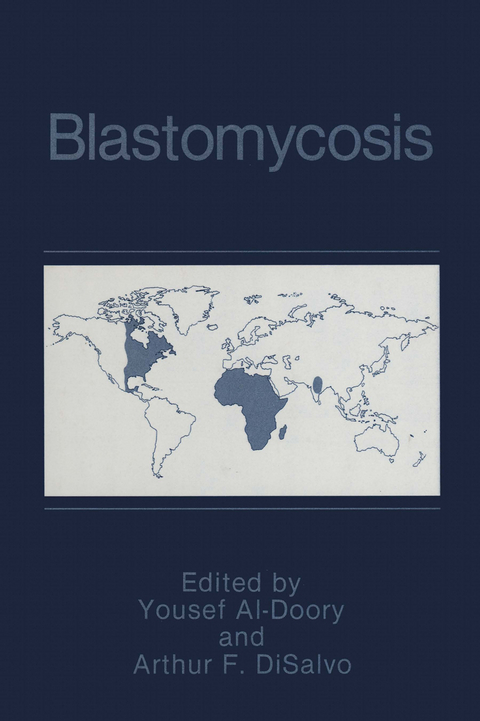
Blastomycosis
Springer-Verlag New York Inc.
978-1-4613-6455-9 (ISBN)
1 Introduction.- 1. History.- 2. The Disease.- 3. The Fungus.- References.- 2 Taxonomy and Biology of Blastomyces Dermatitidis.- 1. Introduction.- 2. Taxonomy.- 3. Morphology.- 4. Ultrastructure.- 5. Genetics and Reproduction.- 6. Physiology.- 7. Dimorphic Phase Transition.- 8. Summary.- References.- 3 Virulence of Blastomyces Dermatitidis.- 1. In Vivo.- 2. In Vitro.- 3. Virulence Factors.- References.- 4 The Ecology of Blastomyces Dermatitidis.- 1. Introduction.- 2. Source in Nature.- 3. Experimental Ecology.- 4. Geographic Distribution.- 5. Conidia as Infectious Particles.- 6. Isolation from Nature.- 7. Summary.- References.- 5 The Epidemiology of Blastomycosis.- 1. Introduction.- 2. Transmission.- 3. Incubation Period.- 4. Skin Testing.- 5. Demographic Aspects.- 6. Outbreaks.- 7. Possible Hosts.- 8. Occupational Mycosis.- 9. Seasonality.- 10. Strain Synonyms.- 11. Summary.- References.- 6 Diagnosis of Blastomycosis.- 1. Specimen Selection.- 2. Specimen Collection.- 3. Direct Microscopic Examination.- 4. Processing and Culturing Clinical Specimens.- 5. Identification.- References.- 7 Immunodiagnosis of Blastomycosis.- 1. Introduction.- 2. Diagnostic Tests.- 3. Summary.- References.- 8 Immunology of Blastomycosis.- 1. Introduction.- 2. Inflammatory Response to B. dermatitidis.- 3. Antigens of B. dermatitidis.- 4. Genetic Factors in Resistance to B. dermatitidis Infection.- 5. Natural Resistance to B. dermatitidis Infection.- 6. Acquired Resistance to B. dermatitidis Infection.- 7. Immunomodulation.- 8. Summary.- References.- 9 Clinical Aspects of Blastomycosis.- 1. Introduction.- 2. Pulmonary Blastomycosis.- 3. Extrapulmonary Infections.- 4. Blastomycosis in Pregnancy.- 5. Combined Fungal Infections.- 6. Blastomycosis in Children.- 7. Compromised Host.- References.- 10Pathologic Features of Blastomycosis.- 1. Clinicopathologic Features.- 2. Gross Pathology.- 3. Morphologic and Tinctorial Features of B. dermatitidis in Tissue Sections.- 4. Microscopic Pathology.- 5. Immunohistologic Diagnosis: Applications and Current Status.- 6. Differential Diagnosis.- References.- 11 Experimental Blastomycosis.- 1. Introduction.- 2. Experimental Infection and Pathogenicity.- 3. Importance of Cellular Immunity in Blastomycosis.- 4. Cell-Mediated Immunoprotection in Blastomycosis (Whole Animal Study).- 5. Immune Monitoring in Blastomycosis.- 6. Thymosin, Lymphotoxin, and Immune Reaction.- 7. B. dermatitidis as a Biologic Response Modulator.- 8. Immunoadjuvant Effects of B. dermatitidis against EL4 Lymphoma.- References.- 12 Prognosis and Therapy of Blastomycosis.- 1. Introduction.- 2. Initiation of Therapy.- 3. Amphotericin B.- 4. Ketoconazole.- 5. Itraconazole.- 6. Other Modes of Therapy.- 7. Summary.- References.- 13 Blastomycosis in Animals.- 1. Introduction.- 2. Epidemiology of Blastomycosis in Animals.- 3. Clinical Aspects of Animal Blastomycosis.- 4. Diagnostic Procedures.- 5. Therapy.- 6. Prognostic Factors.- 7. Public Health Aspects of Animal Blastomycosis.- References.
| Reihe/Serie | Current Topics in Infectious Disease |
|---|---|
| Zusatzinfo | XIX, 268 p. |
| Verlagsort | New York, NY |
| Sprache | englisch |
| Maße | 152 x 229 mm |
| Themenwelt | Medizin / Pharmazie ► Gesundheitswesen |
| Medizin / Pharmazie ► Medizinische Fachgebiete ► Mikrobiologie / Infektologie / Reisemedizin | |
| Studium ► Querschnittsbereiche ► Epidemiologie / Med. Biometrie | |
| Studium ► Querschnittsbereiche ► Infektiologie / Immunologie | |
| Studium ► Querschnittsbereiche ► Prävention / Gesundheitsförderung | |
| ISBN-10 | 1-4613-6455-8 / 1461364558 |
| ISBN-13 | 978-1-4613-6455-9 / 9781461364559 |
| Zustand | Neuware |
| Haben Sie eine Frage zum Produkt? |
aus dem Bereich


